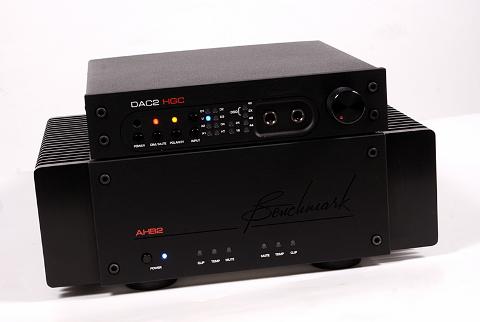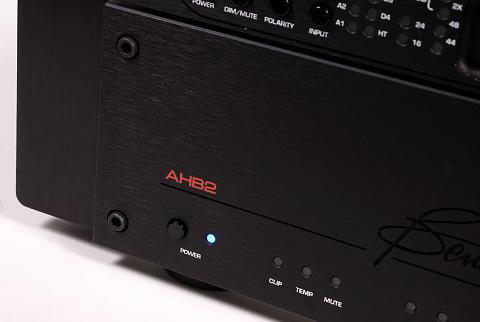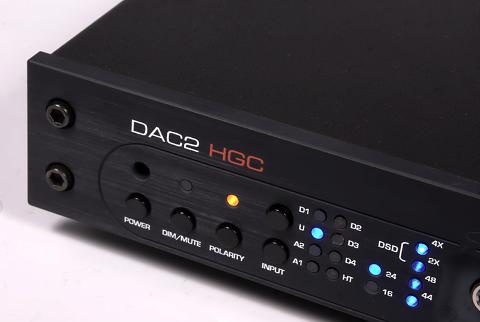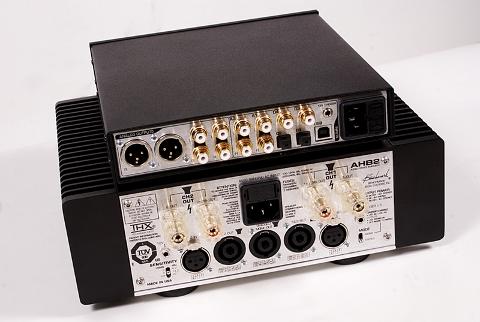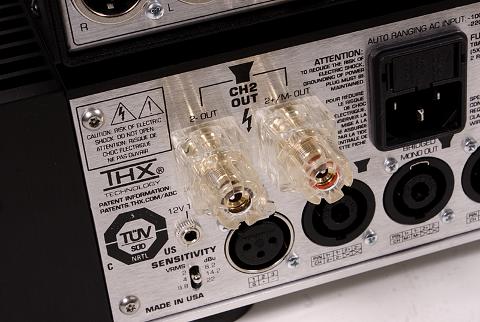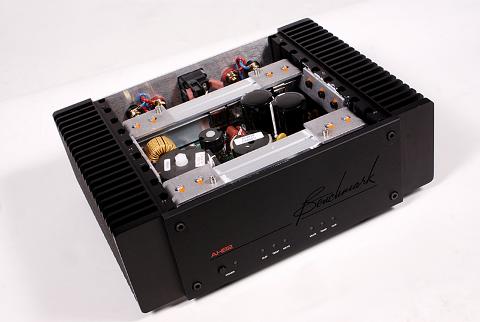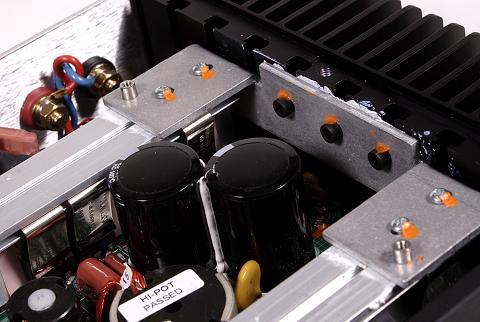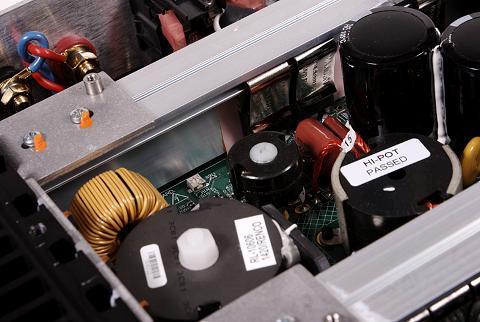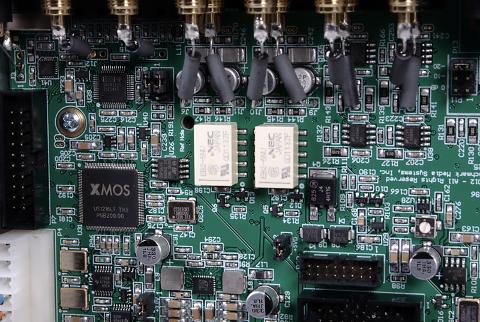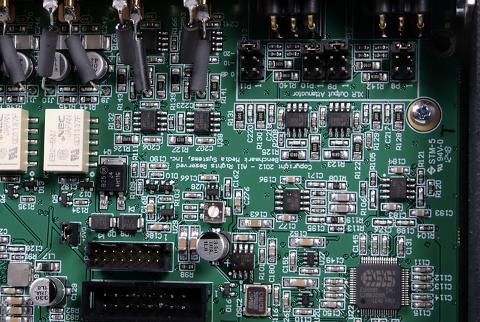about Audio, High Fidelity
& Home Entertainment technologies
pid: 607-2025/10/01 (v1.2)
Privacy Policy
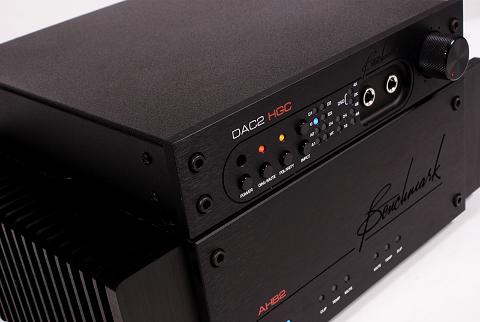
In terms of aesthetics, Benchmark's intention to design an amplifier "matched" to the DAC2 is quite evident: The two devices chassis have the same standard width (power amp's heatsinks are extended so there are no restrictions on air flow) and AHB2's front panel, although much simpler than the DAC's, has the same basic design. It is easy, therefore, to envision the pair to work together on a rack or a flat surface, without taking up considerable space, forming a full-spec amplification system particularly if both the rich connectivity options of the DAC2 and the power offered by AHB2 are taken into consideration. Both devices are available in the two Benchmark standard finishes (silver and black matte) and, additionally, both feature an optional 19-inch standard rack mounting kit, addressed to those who intend to integrate the devices into a professional installation.
Although nowhere explicitly stated, the AHB2 appears to be designed to perfectly match the DAC2 HGC, thus creating a quite interesting device combination, which includes a very good DAC and a headphone amplifier. All that one needs to add is a media player and a pair of loudspeakers.
The DAC2 HGC features two coaxial and two optical S/PDIF inputs, a USB port capable of asynchronous streaming up to 24/192, and two analog single-ended inputs. There are both single-ended and balanced analog outputs, the latter with output level selection (via jumper setting inside the device), two headphone outputs, and a coaxial digital output which is optional in the sense that the user should sacrifice one of the two digital inputs, again through setting jumpers located inside the device.
The AHB2 only has balanced inputs whose sensitivity is adjusted in three steps between 2 and 9.8Vrms and two sets of outputs for connection to loudspeakers. Of these, one is a standard binding post set (with good quality terminals suitable for the majority of cables) while the second one is based on Neutrik Speakon NL4 terminals. These terminals are quite common in professional equipment and, according to Benchmark, they offer a much better connection quality, therefore, they should be preferred in any case. AHB2 offers three Speakon outputs, two for driving the respective left and right loudspeakers when the amplifier is used as a two-channel device and one to be used when the mono/bridged mode (monoblock) is selected. Bridging is controlled through a small switch located on the back of the chassis, adjacent to the terminals. There is, also, a combined L/R Speakon terminal (one of these used during the two-channel operation) to drive bi-amp capable loudspeakers. Obviously, if the L/R bi-amp mode or the bridged mode is used, you need two amplifiers to complete a two-channel system.
AHB2's faceplate includes a number of LEDs to indicate the state of the circuit (separate for each channel) and the on-off switch.
The input selector, the bitrate display (for the digital signals), a phase selector switch and a mute switch are available in DAC2's front panel.
The amplifier's front panel features, except for the power switch, separate indicators for the operation of each channel, including mute, clipping, and overheating protection.
DAC2's analog stage features LME49860 operational amplifiers (a part designed by Texas Instruments specifically for high-end audio applications) and uses a motor-driven potentiometer from Alps for level adjustment. The potentiometer serves both as an analog-domain level control, when analog inputs are used and as the encoder for a 32-bit digital gain control for the digital signals. Benchmark calls this triple approach (analog/digital domain gain control and passive output attenuators) a "Hybrid Gain Control" hence the relative addition of “HGC” in the device name. DAC2 features a switching power supply and the necessary local regulator circuits. The DAC2 HGC is accompanied by a full remote control that allows input selection, volume adjustment, and mute control.
The effort to create a power amp in a compact size requires the implementation of a highly compact chassis that hides many of the aspects of AHB2's circuit structure. However, there are many available details that are interesting. Although both the Benchmark and the THX do not give very detailed information on the AAA technology, we know that AHB2 is an H class amplifier with a switch-mode power supply. The H class should not be confused with the "H-bridge" used often in class D output stages. It is essentially a linear class AB topology with automatic selection of its supply voltage, depending on the signal level. In practice, a class H amplifier features two or more pairs of power supply rails, from which automatically selects the appropriate one (one of a high voltage in program peaks and one of a lower voltage when the power requirements are not so high), a behavior that increases the efficiency and reduces thermal losses. Besides the fact that an H class amplifier circuit is more complex than a standard AB class, this circuit topology seems to introduce more crossover distortion compared with an AB class circuit whose bias current is strictly controlled and sometimes set at a higher value, so that for a small percentage of its power -or for the "first watt"- the circuit behaves like an A class amplifier, a common practice in many amps. The later is, probably, the most important reason why H class amplifiers are not often used in audio applications. At this point, Benchmark and THX have a completely different approach: The AHB2 is a class AB amplifier with a low bias current, its crossover distortion controlled -up to total elimination- through a topology often referred to as Feed-Forward Error Correction. The precise architecture of the system is, probably, the main subject that the THX/AAA patent protects, but this topology in its general form has been known for decades. There have been references by Harold Black himself (the man who first described accurately the idea of negative feedback in amplifiers) back in the 1920s and, also, P.J. Walker offered a relevant analysis in his article "Current Dumping Audio Amplifier", where the Quad circuit of the same name was described (Wireless World 12/1975). More recently both Vanderkooy and Lipshitz ("Feedforward Error Correction in Power Amplifiers" JAES 1/2, 1980) and Giovanni Stochino ("Audio Design Leaps Forward", Electronics World & Wireless World, 10/1994) offered some more mathematical oriented and rigorous analysis for this type of amplifier error correction method (if interested, you should try to google these resources, with some effort you will locate the original texts).
The preamplifier offers a complete set of analog and digital inputs and has a balanced output. The power amplifier includes both conventional binding posts and Speakon terminals for connecting the loudspeakers, Benchmark clearly suggesting the later as a better quality choice.
The amplifier offers sensitivity adjustment through a small switch (bottom left). The middle Speakon terminal is to operate the amplifier in mono mode (bridged).
The general structure of such an amplifier comprises an AB class power stage (in the case of AHB2 the power stage belongs to the H class) and an auxiliary amplifier of very low distortion, usually an A class, wide bandwidth, high slew rate stage. These characteristics can be easily achieved if the circuit is of low power, as in this case. The auxiliary amplifier receives and boosts a control signal derived from the output of the main amplifier and the resulting correction signal is fed to the output through an appropriate network. In theory, the correction signal is the inverse (mirror-image) of the error appearing at the output of the main amplifier. From this simple description (a complete but quite easy to follow mathematical analysis can be found in Stochino's article), the main difference arises between the feed-forward correction method and the conventional, negative feedback, method: Although the control signal is derived in both cases from the amplifier output, the former method applies the correction directly to the output while the later to its input. Feed-forward error correction proponents consider this approach to offer much better correction margins, therefore, could provide a much more accurate output. Benchmark published on their site some AHB2's measurements showing that crossover distortion is almost zero when the amplifier delivers very low power.
As already mentioned, AHB2 features a switch-mode power supply. This approach ensures, according to Benchmark, two advantages. Firstly minimizes the power line noise (50/100Hz) and second, offers the possibility of using a fully regulated power supply for the whole circuit (not just for the input/voltage gain stages, as usually). AHB2's regulated power supply minimizes the need for a large capacitance filter, therefore, the amplifier lacks the usual array of smoothing capacitors encountered in conventional amplifiers. To further reduce artifacts, Benchmark uses a high-frequency resonant switch-mode power supply, where the power devices switch when their load is at a minimum, further reducing high-frequency noise.
The AHB2 is a very dense device, which is justified on the basis of the type of circuit and the compact size of the chassis.
This photo shows the power semiconductors, assembled to the heatsink. Power supply capacitors are a pair of 1.500uF/200V components. HBA2 lacks the conventional smoothing capacitor bank, most amps with a linear, unregulated power supply, need.
A traditional large power transformer is, also, missing. The Benchmark approach to the power supply is different and, judging from the result, quite successful.
The digital signal processing includes an asynchronous rate converter (top left) and Benchmark's UltraLock2. Streaming via USB is controlled through an XMOS solution. The DAC chip is the ES9018 from ESS.
DAC2 HGC features Texas Instrument's LME49860 op-amps for the whole analog stage, including the I/V converters. Just below the XLR connectors appear the jumpers which control the balanced output level.
Previous | Next | More Reviews

